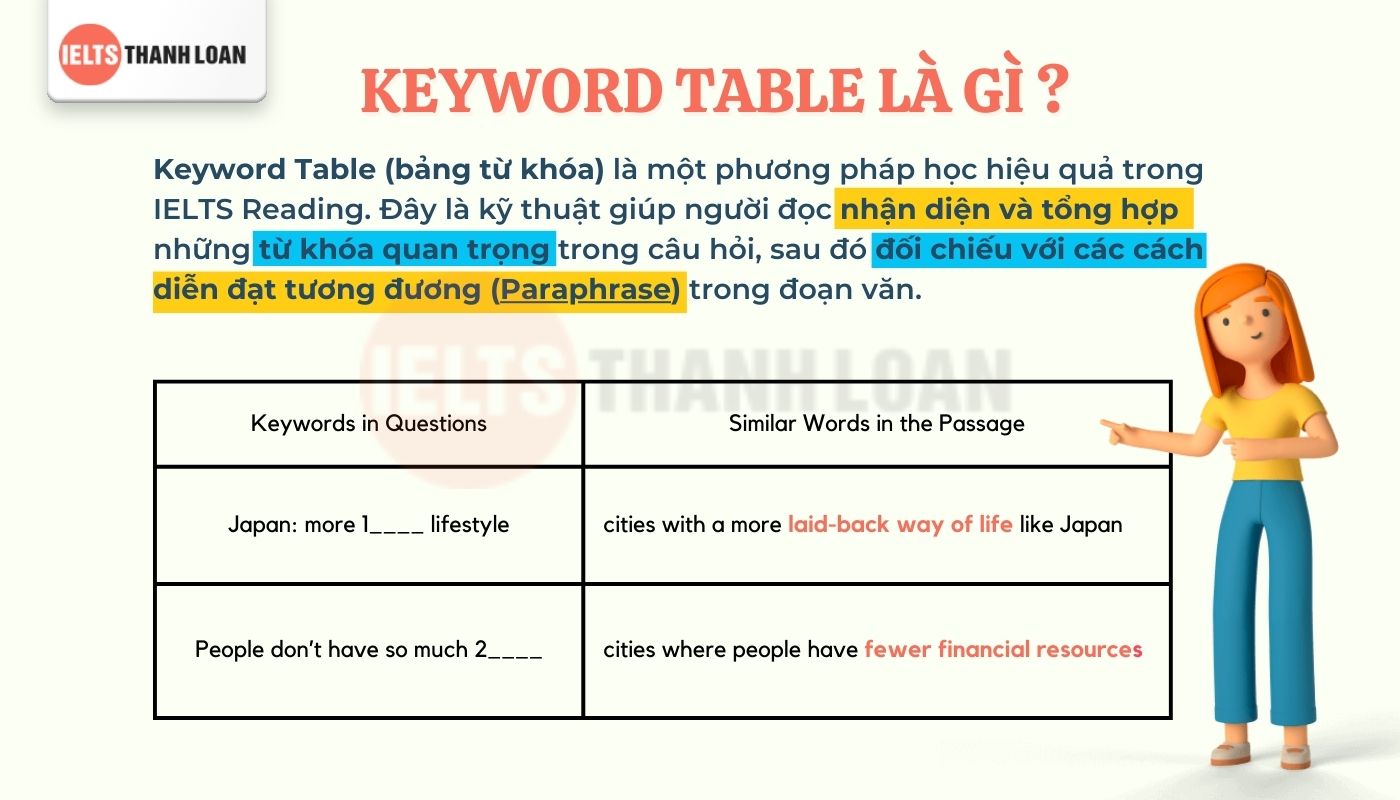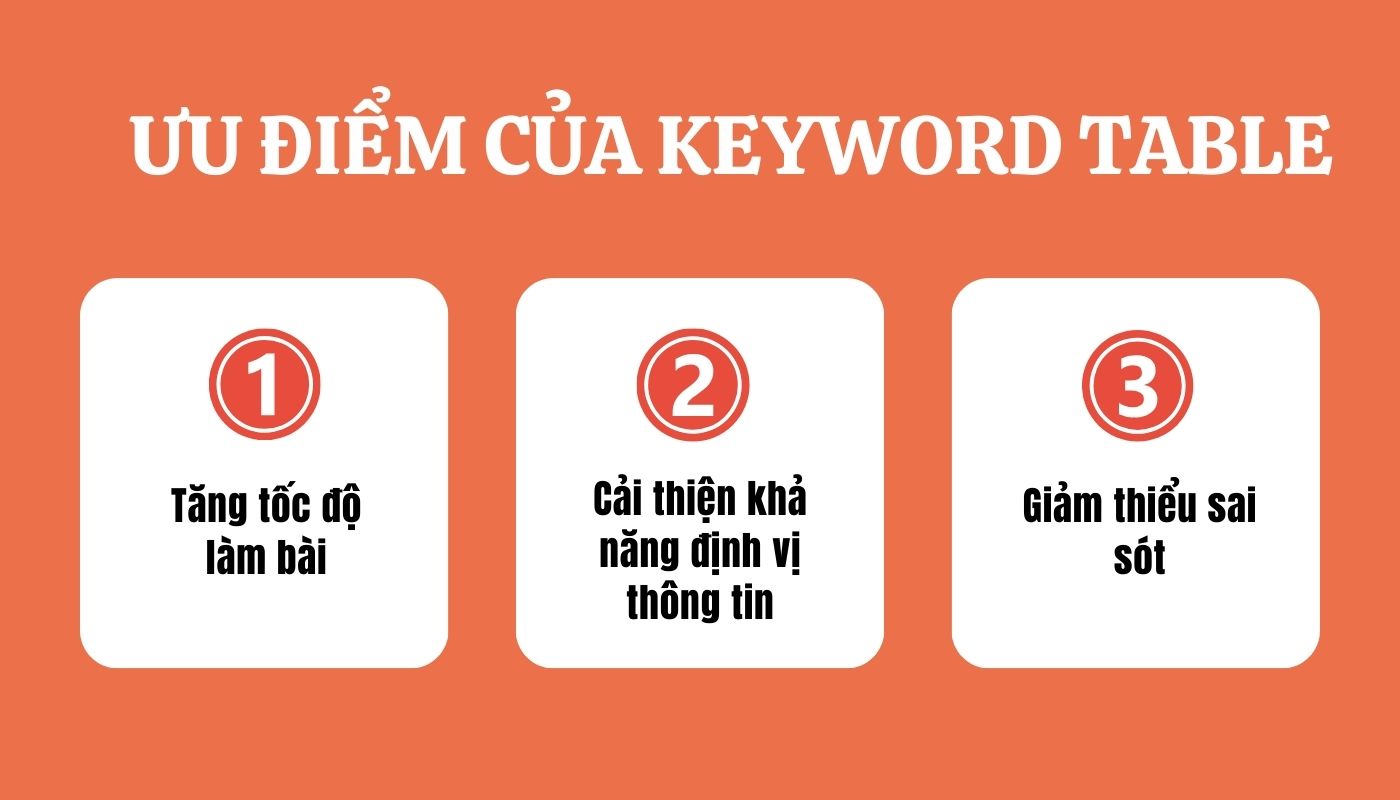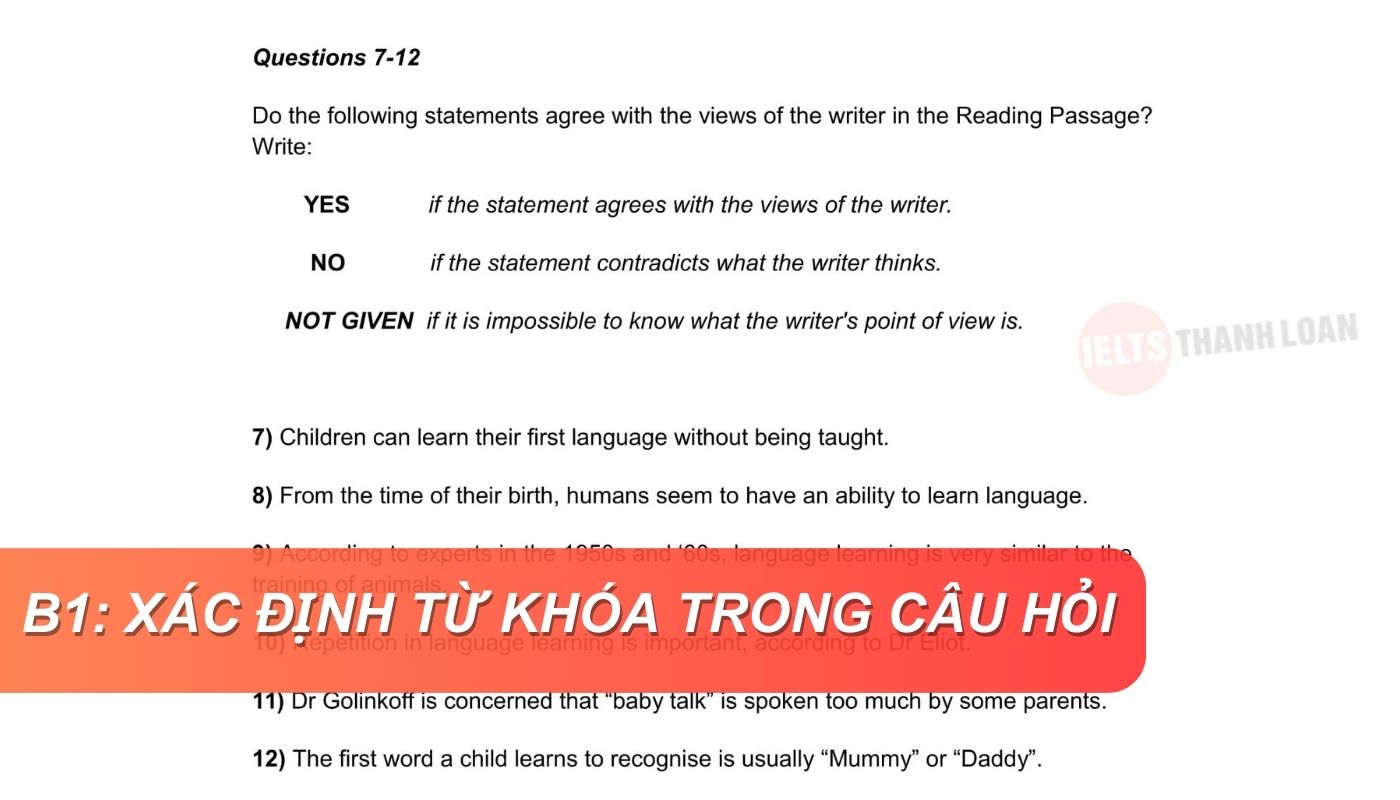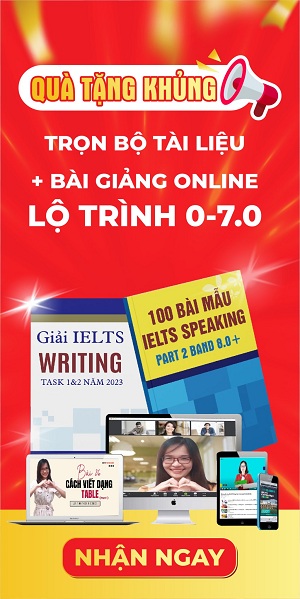Định vị thông tin nhanh, chính xác là yếu tố then chốt để tiết kiệm thời gian khi làm bài thi IELTS Reading. Trong đó, Keyword Table – bảng từ khóa chính là một công cụ hỗ trợ đắc lực trong quá trình làm bài. Không chỉ giúp người đọc phân tích câu hỏi nhanh chóng, Keyword Table còn rèn luyện kỹ năng Scanning và Paraphrase – hai kỹ năng cốt lõi để chinh phục điểm số cao trong phần thi đọc hiểu. Vậy, Keyword Table là gì và ứng dụng như thế nào hiệu quả? Hãy cùng Trung tâm IELTS Thanh Loan tìm hiểu chi tiết qua bài viết sau đây!
| Key Takeaways |
|
Định nghĩa: Keyword Table là kỹ thuật giúp hệ thống các từ khóa quan trọng trong câu hỏi, từ đó xác định các cách diễn đạt tương đương trong bài đọc IELTS Reading. Cách áp dụng Keyword Table:
|
Keyword table là gì?
Keyword Table (bảng từ khóa) là một phương pháp học hiệu quả trong IELTS Reading được chính thầy Simon – cựu giám khảo IELTS – khuyến khích áp dụng. Đây là kỹ thuật giúp người đọc nhận diện và tổng hợp những từ khóa quan trọng trong câu hỏi, sau đó đối chiếu với các cách diễn đạt tương đương (Paraphrase) trong đoạn văn. Nhờ đó, thí sinh có thể nắm bắt thông tin nhanh chóng, chính xác hơn trong quá trình làm bài.

Bảng Keyword Table for IELTS Reading
Một Keyword Table IELTS điển hình sẽ bao gồm 2 cột:
- Keywords in Questions: Ghi lại các từ khóa chính xuất hiện trong câu hỏi.
- Similar Words in the Passage: Tìm và ghi chú các từ/cụm từ tương đương xuất hiện trong bài đọc.
Ví dụ về cách lập bảng Keyword Table:
| Keywords in Questions | Similar Words in the Passage |
| Japan: more 1____ lifestyle | cities with a more laid-back way of life like Japan |
| People don’t have so much 2____ | cities where people have fewer financial resources |
→ Trong ví dụ trên:
- Cụm “more ____ lifestyle” được paraphrase thành “laid-back way of life”.
- “don’t have so much ____” được chuyển thành “fewer financial resources”.
Ưu điểm khi ứng dụng Keyword Table là gì?

Tìm hiểu những ưu điểm khi ứng dụng Keyword Table là gì?
- Tăng tốc độ làm bài: Thay vì phải đọc toàn bộ đoạn văn, bạn chỉ cần đối chiếu các từ khóa trong bảng Keyword Table với bài đọc, từ đó tiết kiệm đáng kể thời gian và tăng tốc độ làm bài.
- Cải thiện khả năng định vị thông tin: Với bảng Keyword Table, bạn có thể nhanh chóng xác định được đoạn chứa câu trả lời mà không cần đọc lan man. Điều này đặc biệt hữu ích cho dạng câu hỏi tìm thông tin chi tiết trong bài đọc.
- Giảm thiểu sai sót: Sử dụng Keyword Table Simon giúp bạn tìm kiếm thông tin một cách logic, tránh bỏ sót dữ kiện quan trọng và hạn chế nhầm lẫn giữa các đáp án.
Tổng quan các bước lập bảng Keyword Table
Để áp dụng hiệu quả phương pháp Keyword Table trong IELTS Reading, bạn cần nắm rõ trình tự các bước lập bảng keyword như sau:
Bước 1: Xác định các từ khóa chính trong câu hỏi
Trước khi đọc đoạn văn, bạn hãy dành thời gian đọc kỹ toàn bộ câu hỏi. Trong đó, gạch chân các từ khóa trọng tâm như: “why”, “how”, “what”, “when”, “where”, cũng như những cụm từ chỉ định: “the first”, “the last”, “most”, “least”. Đây là những tín hiệu giúp bạn xác định trọng tâm câu hỏi khi xây dựng Keyword Tables.

Bước 1 – xác định các từ khóa trong câu hỏi
Bước 2: Tìm từ đồng nghĩa với những từ khóa đã gạch ra trong bài đọc
Sau khi có danh sách từ khóa trong câu hỏi, bạn chuyển sang quét đoạn văn để tìm các từ/cụm từ mang ý nghĩa tương đương. Các từ này có thể là danh từ, động từ, tính từ hoặc cụm paraphrase.
*Lưu ý rằng bài đọc thường sử dụng nhiều cách diễn đạt khác nhau. Do đó, bạn cần rèn luyện kỹ năng nhận diện từ đồng nghĩa để xây dựng IELTS Reading Keyword Table chính xác.

Bước 2 – tìm từ đồng nghĩa với những từ khóa đã gạch ra trong bài đọc
Bước 3: Tạo bảng Keyword Table hoàn chỉnh
Khi đã tổng hợp đủ từ khóa ở cả câu hỏi và đoạn văn, bạn tiến hành tạo bảng từ khóa để hệ thống hóa và dễ dàng đối chiếu.
Nếu bạn vẫn còn băn khoăn Keyword Table là gì thì đây chính là công cụ hỗ trợ scanning thông tin nhanh giữa câu hỏi và đoạn văn bằng cách sắp xếp từ khóa theo cấu trúc rõ ràng. Một bảng Keyword Table nên gồm ba cột: Câu hỏi, Từ khóa trong câu hỏi và Từ khóa trong đoạn văn.
Ví dụ về cách lập bảng Keyword Table:
| Câu hỏi | Từ khóa trong câu hỏi | Từ khóa trong đoạn văn |
| What is the key message of the article? | key message, article | main idea, text |
| In what way is the experiment illustrated by the writer? | illustrate, experiment | demonstrate, test |
Ví dụ cách ứng dụng Keyword Table trong IELTS Reading
Để hiểu rõ hơn về Keyword Table là gì và cách áp dụng vào bài thi thực tế, chúng ta hãy cùng phân tích ví dụ từ Cambridge 9 – Test 3 – Passage 1: “Attitudes to language”
>>Xem ngay: Giải đề IELTS Reading Cambridge 9 Test 3: Dịch đề, Phân Tích đáp án

Ví dụ minh họa cách ứng dụng Keyword Table trong IELTS Reading
ĐỀ BÀI
|
“It is not easy to be systematic and objective about language study. Popular linguistic debate regularly deteriorates into invective and polemic. (1)Language belongs to everyone, so most people feel they have a right to hold an opinion about it. And when opinions differ, emotions can run high. (2)Arguments can start as easily over minor points of usage as over major policies of linguistic education. Language, moreover, is a very public behavior so it is easy for different usages to be noted and criticized. No part of society or social behavior is exempt: (3)linguistic factors influence how we judge personality, intelligence, social status, educational standards, job aptitude, and many other areas of identity and social survival. As a result, it is easy to hurt, and to be hurt, when language use is unfeelingly attacked. …..” |
CÂU HỎI
|
Questions 1-3 Do the following statements agree with the claims of the writer in Reading Passage? In boxes 1-8 on your answer sheet, write
1. There are understandable reasons why arguments occur about language. 2. People feel more strongly about language education than about small differences in language usage. 3. Our assessment of a person’s intelligence is affected by the way he or she uses language. |
⇒ Cách lập bảng Keyword Table:
Bước 1: Xác định từ khóa trong câu hỏi
| Câu hỏi | Từ khóa chính |
| 1 | arguments, occur, language |
| 2 | feel strongly, language education, small differences |
| 3 | assessment, affected by, the way uses language |
Bước 2: Tìm từ/cụm từ tương đương trong đoạn văn
- Small → Minor
- Assessment → Judge
- Be affected by → Influence
- The way he or she uses language → Linguistic factors
Bước 3: Lập bảng Keyword Table để đối chiếu
| Keywords in Questions | Similar Words in Passage |
| Small | Minor |
| Assessment | Judge |
| The way he or she uses language | Linguistic factors |
| Be affected by | Influence |
⇒ Kết quả và phân tích đáp án:
| Câu hỏi | Đáp án | Giải thích |
| 1 | YES | Bài đọc nói rõ rằng tranh luận về ngôn ngữ xảy ra dễ dàng và là điều phổ biến. |
| 2 | NO | Đoạn văn cho rằng cảm xúc có thể bùng lên ngay cả với những điểm nhỏ trong cách dùng ngôn ngữ (mâu thuẫn với phát biểu trong câu hỏi). |
| 3 | YES | Tác giả khẳng định linguistic factors ảnh hưởng đến việc đánh giá intelligence (đúng với ý câu hỏi). |
Bài tập vận dụng phương pháp Keyword Table
*Trích từ “Cambridge 9 Test 3 Passage 3: Information theory – the big idea.”

Bài tập vận dụng Keyword Table
Đề bài:
- A. (31) In April 2002 an event took place which demonstrated one of the many applications of information theory. The space probe, Voyager I, launched in 1977, had sent back spectacular images of Jupiter and Saturn and then soared out of the Solar System on a one-way mission to the stars. After 25 years of exposure to the freezing temperatures of deep space, the probe was beginning to show its age. Sensors and circuits were on the brink of failing and NASA experts realised that they had to do something or lose contact with their probe forever. The solution was to get a message to Voyager I to instruct it to use spares to change the failing parts. With the probe 12 billion kilometres from Earth, this was not an easy task. By means of a radio dish belonging to NASA’s Deep Space Network, the message was sent out into the depths of space. Even travelling at the speed of light, it took over 11 hours to reach its target, far beyond the orbit of Pluto. Yet, incredibly, the little probe managed to hear the faint call from its home planet, and successfully made the switchover.
- B. It was the longest-distance repair job in history, and a triumph for the NASA engineers. But it also highlighted the astonishing power of the techniques developed by American communications engineer Claude Shannon, who had died just a year earlier. Born in 1916 in Petoskey, Michigan, Shannon showed an early talent for maths and for building gadgets, and made breakthroughs in the foundations of computer technology when still a student. (29) While at Bell Laboratories, Shannon developed information theory, but shunned the resulting acclaim. In the 1940s, he single-handedly created an entire science of communication which has since inveigled its way into a host of applications, from DVDs to satellite communications to bar codes – any area, in short, where data has to be conveyed rapidly yet accurately.
- C. (32) This all seems light years away from the down-to-earth uses Shannon originally had for his work, which began when he was a 22-year-old graduate engineering student at the prestigious Massachusetts Institute of Technology in 1939. He set out with an apparently simple aim: to pin down the precise meaning of the concept of ‘information’. The most basic form of information, Shannon argued, is whether something is true or false – which can be captured in the binary unit, or ‘bit’, of the form 1 or 0. Having identified this fundamental unit, Shannon set about defining otherwise vague ideas about information and how to transmit it from place to place. In the process he discovered something surprising: it is always possible to guarantee information will get through random interference – ‘noise’ – intact.
- D. Noise usually means unwanted sounds which interfere with genuine information. Information theory generalises this idea via theorems that capture the effects of noise with mathematical precision. In particular, Shannon showed that noise sets a limit on the rate at which information can pass along communication channels while remaining error-free. (27) This rate depends on the relative strengths of the signal and noise travelling down the communication channel, and on its capacity (its ‘bandwidth’). The resulting limit, given in units of bits per second, is the absolute maximum rate of error-free communication given signal strength and noise level. The trick, Shannon showed, is to find ways of packaging up – ‘coding’ – information to cope with the ravages of noise, while staying within the information-carrying capacity – ‘bandwidth’ – of the communication system being used.
- E. Over the years scientists have devised many such coding methods, and they have proved crucial in many technological feats. The Voyager spacecraft transmitted data using codes which added one extra bit for every single bit of information; the result was an error rate of just one bit in 10,000 – and stunningly clear pictures of the planets. (30) Other codes have become part of everyday life – such as the Universal Product Code, or bar code, which uses a simple error-detecting system that ensures supermarket check-out lasers can read the price even on, say, a crumpled bag of crisps. As recently as 1993, engineers made a major breakthrough by discovering so-called turbo codes – which come very close to Shannon’s ultimate limit for the maximum rate that data can be transmitted reliably, and now play a key role in the mobile videophone revolution.
- F. (28) Shannon also laid the foundations of more efficient ways of storing information, by stripping out superfluous (‘redundant’) bits from data which contributed little real information. As mobile phone text messages like ‘I CN C U’ show, it is often possible to leave out a lot of data without losing much meaning. As with error correction, however, there’s a limit beyond which messages become too ambiguous. Shannon showed how to calculate this limit, opening the way to the design of compression methods that cram maximum information into the minimum space.
Questions 27-32
Reading Passage has six paragraphs, A-F.
Which paragraph contains the following information?
Write the correct letter, A-F, in boxes 27-32 on your answer sheet.
- an explanation of the factors affecting the transmission of information
- an example of how unnecessary information can be omitted
- a reference to Shannon’s attitude to fame
- details of a machine capable of interpreting incomplete information
- a detailed account of an incident involving information theory
- a reference to what Shannon initially intended to achieve in his research
Đáp án:
- D
- F
- B
- E
- A
- C
→ Bạn có thể tham khảo cách lập bảng Keyword table dưới đây:
| Keywords in Questions | Similar words in Passage |
| Unnecessary | Superfluous |
| Omit | Strip out |
| Fame | Acclaim |
| Incident | Event |
| Initially | Originally |
Nắm vững các kỹ năng làm bài IELTS Reading cùng IELTS Thanh Loan
Để chinh phục band điểm cao trong bài thi IELTS Reading, người học không chỉ cần trau dồi khả năng đọc hiểu mà còn cần chú trọng đến tư duy trả lời câu hỏi và kỹ năng làm bài – đặc biệt là cách nhận diện từ khóa, kỹ thuật paraphrase cùng bộ đôi Scanning & Skimming.
Tại IELTS Thanh Loan, tất cả những kỹ năng này sẽ được giảng dạy một cách dễ hiểu – dễ áp dụng – đúng trọng tâm thông qua khóa học IELTS Online được thiết kế cá nhân hóa theo trình độ và mục tiêu đầu ra. Học viên không chỉ được học lý thuyết mà còn thực hành trực tiếp trên các bài đọc chuẩn Cambridge, ứng dụng các phương pháp như Keyword Table, mapping ideas và phân tích dạng câu hỏi theo bài thi thực tế.
Bên cạnh đó, khóa học còn đi kèm hệ thống bài tập, file ghi chú, feedback chấm chữa chi tiết giúp học viên tiến bộ rõ rệt qua từng tuần học. Dù bạn bắt đầu từ con số 0 hay hướng đến mục tiêu IELTS 6.5+, khóa học IELTS Online tại IELTS Thanh Loan sẽ giúp bạn từng bước làm chủ kỹ năng Reading, đồng thời phát triển toàn diện cả Listening, Writing và Speaking Skills theo lộ trình tối ưu nhất.
Liên hệ ngay IELTS Thanh Loan để nhận tư vấn chi tiết về học phí và chương trình luyện thi phù hợp nhé!
Như vậy, sử dụng Keyword Table không chỉ giúp bạn tiết kiệm thời gian khi làm bài IELTS Reading mà còn nâng cao khả năng nhận diện thông tin một cách chính xác. Hy vọng với những thông tin hữu ích mà IELTS Thanh Loan đã chia sẻ, bạn sẽ hiểu rõ hơn về Keyword Table là gì và nắm vững cách vận dụng hiệu quả trong bài thi thực tế.















